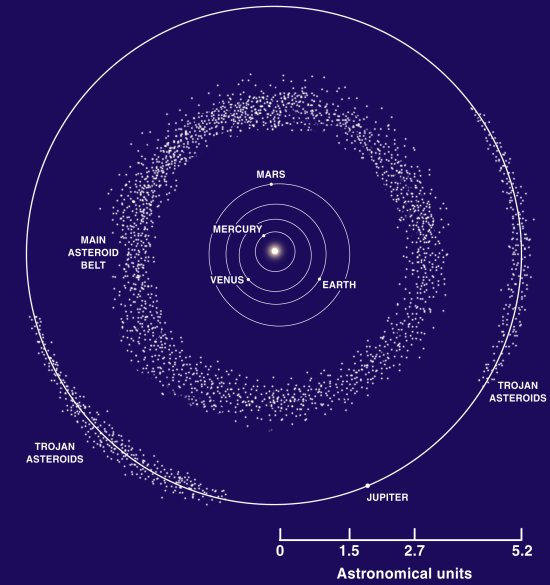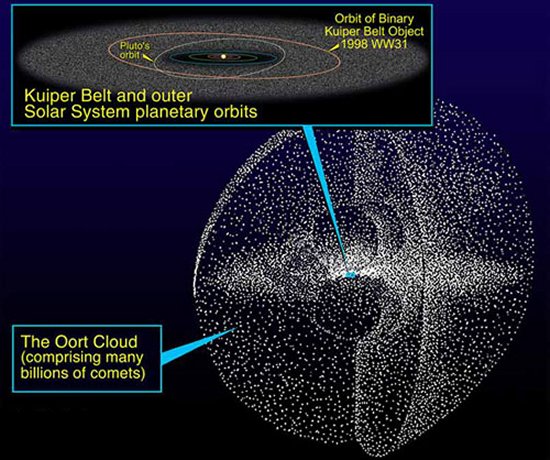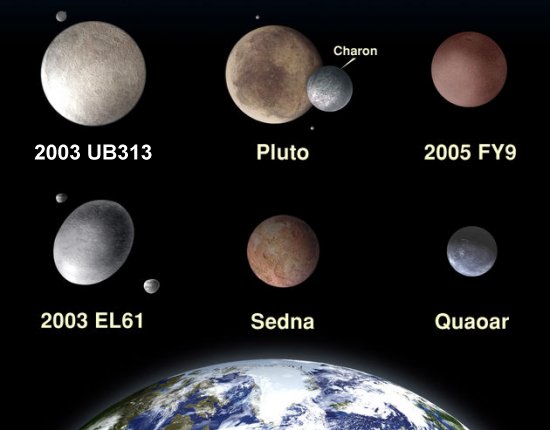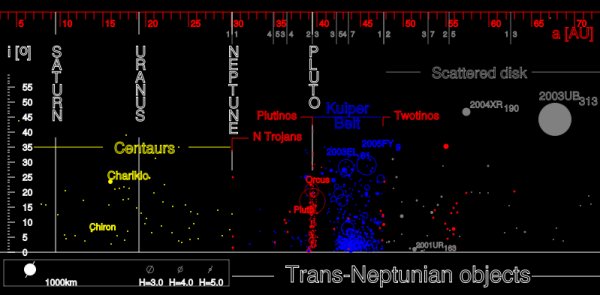|
||||||||||
|
|
||||||||||
|
||||||||||
|
|
||||||||||
The greatest advocate of the existence of this ninth planet was American astronomer Percival Lowell who searched for the so-called "Planet X" until his death in 1916. Lowell as well as the astronomers William Pickering and Venkatesh Ketakar had each made calculations predicting where this undiscovered planet might be. Although Clyde Tombaugh discovered Pluto very close to the location the earlier astronomers had predicted, the new object was far too small to account for any of the presumed anomalies in the orbits of Uranus and Neptune. In fact, these discrepancies turned out to be non-existent and were only the result of errors made in estimating the mass of each of these large worlds. It was pure coincidence that the predictions of Lowell and his colleagues happened to come close to where tiny Pluto was ultimately found.

Since Tombaugh and other astronomers were actively searching for a new planet at the time Pluto was discovered, they naturally assumed the new object was indeed a planet and never questioned whether it might be otherwise. As more was learned about this distant planet, however, it became clear the world was an anomaly. The four inner planets of the solar system are all relatively small with a similar rocky composition while the next four planets are massive gas giants. Pluto, by comparison, is a tiny world smaller than any other planet and consists largely of ice.
Pluto also follows a very unusual orbit compared to the other planets of the solar system. All planets orbit the Sun in an elliptical path that is slightly elongated from a true circle. This elongation from a perfect circle is referred to as eccentricity. The more elliptical an orbit is, the greater its eccentricity. The eccentricity of the orbits of most of the planets is generally quite small. Pluto's orbit is so eccentric that it actually crosses that of Neptune, making Neptune the furthest planet from the Sun for about 20 Earth years. The orbits of most of the planets also lie within the same ecliptic plane. Pluto, on the other hand, is inclined over 17° away from this plane.

Despite these unusual characteristics, Pluto appeared to be a unique object and astronomers accepted it as a planet for decades. That assumption remained unchallenged until 1992 when astronomers began discovering additional large objects beyond the orbit of Neptune. Now called Trans-Neptunian Objects (TNO), astronomers have discovered hundreds of bodies in this region of the solar system. Many of these objects are icy bodies comparable in size and orbital characteristics to Pluto. Some are even called "Plutinos" because they are so similar to the planet. The discovery of so many of these objects caused the astronomy community to begin questioning whether Pluto still deserves to be considered a planet and also raised the larger question of how a planet should be defined in the first place.
The question of Pluto's status is not the first time this type of debate has erupted in the scientific world. Perhaps the most famous example began in the 1500s when Nicolaus Copernicus challenged the belief that Earth was at the center of the universe and proposed Earth was instead a planet orbiting the Sun. That battle caused a reevaluation of the very foundations of what we now call astronomy. The science of astronomy dates back to the earliest civilizations on Earth. Many of the ideas about our solar system that dominated early astronomy came from the ancient Greeks. Indeed, the English word planet is derived from the Greek word planetes that means "wanderer." This term originated because the points of light created by the planets appear to move, or wander, across the night sky when viewed from Earth. These wandering lights were clearly different from the fixed points of light we now know to be distant stars. The objects that were considered to be planets included not only the five planets known at the time--Mercury, Venus, Mars, Jupiter and Saturn--but also the Sun and the Moon. It was the existence of these seven heavenly bodies that had a profound influence on the religious beliefs and customs of the earliest human civilizations.
As we learned more about the structure of the solar system, these ideas gradually changed. A major revision came with the acceptance that the Sun was at the center of the solar system rather than the Earth. This belief resulted in a reclassification of objects in the solar system once it was realized that the Sun is a star and the Earth a planet orbiting around it. Further clarification came in the 1600s with the discovery of moons around Jupiter and Saturn. While these bodies were originally considered planets, just as our own Moon still was, it was eventually accepted that these worlds should be reclassified as moons in orbit around their parent planets and that only bodies in orbit around the Sun should be called planets.

Still more evolution in our understanding of the heavens came with the discovery of the asteroid belt between Mars and Jupiter. The first of these objects to be discovered was Ceres found in 1801. Like the moons of Jupiter and Saturn, Ceres was also hailed as a new planet upon its discovery. Still more of these objects in nearly the same orbit were to be found over the following decades. By the mid-1800s, four of these bodies were counted as planets while the discovery of a dozen more had prompted debate over the status of such objects. The famous British astronomer William Herschel first suggested these objects be renamed as asteroids, meaning "starlike," during the 1810s, but it was not until the 1860s that astronomers finally demoted the asteroids Ceres, Pallas, Juno, and Vesta from the ranks of planets. Today, objects like asteroids are often referred to as minor planets to distinguish them from the major planets like Jupiter and Earth. While minor planets orbit the Sun, they are too small to meet the modern definition of a true planet.
The same debate that once centered on whether asteroids should be considered as planets is now focused on Pluto and the Trans-Neptunian Objects. To confuse matters even further, TNOs consist of three different types of objects differentiated by their distance from the Sun. Closest to the Sun are objects in the Kuiper Belt. This region extends from the orbit of Neptune at 30 astronomical units (AU) to 50 AU, slightly beyond the furthest point in Pluto's orbit. The Kuiper Belt is home to many small icy objects including short-period comets like Halley's Comet.

Further out from the Sun is a region recently dubbed the Scattered Disk. While containing objects similar to those in the Kuiper Belt, the Scattered Disk extends outward much further and the bodies within it are in far more erratic orbits. Kuiper Belt objects tend to orbit in more circular paths relatively close to the ecliptic plane while those in the Scattered Disk are often far more eccentric and inclined from the ecliptic. Astronomers speculate objects in the Scattered Disk formed within the Kuiper Belt but were thrown outward into their unusual orbits by interactions with the gas giants. Beyond the Scattered Disk at the edge of the Trans-Neptunian region, astronomers speculate that an enormous spherical cloud of icy comets may exist between 50,000 and 100,000 AU from the Sun. Known as the Oort Cloud, this region of space may contain millions or billions of icy objects. Collisions between them or external disturbances occasionally cause some of these objects to fall inward toward the Sun to create comets.
It is this new understanding of the outer regions of the solar system that has forced astronomers to once again reconsider the definition of a planet. Pluto falls within the Kuiper Belt, and the discovery of several similar objects within the same region of space raises the question of whether they should be considered as major or minor planets. Among these new objects are Quaoar that is about one-third the size of Pluto, Orcus with an orbit very similar to Pluto's but at a different inclination, and Sedna that may be two-thirds the size of Pluto but has an extremely eccentric orbit. The debate was most recently brought to a head in 2005 when astronomers announced the discovery of a Trans-Neptunian Object even larger than Pluto. Originally called 2003 UB313 but later renamed Eris, this object lies in a very eccentric and highly inclined orbit that extends from inside the orbit of Neptune out into the Scattered Disk. Given its size and that it has at least one moon in orbit, the discoverers of this object have claimed it should be considered the tenth planet of the solar system.

Other astronomers disagree since the orbit of Eris is far too unusual compared to the traditional planets. The International Astronomical Union (IAU) has instead classified Trans-Neptunian Objects as minor planets since they do orbit the Sun but are too small, often unusually shaped, and follow orbital paths too erratic to be considered major planets. That decision brings into question whether Pluto should still be considered a major planet or be demoted to a minor planet as several asteroids like Ceres had been before. Several observatories have taken matters upon themselves and decided to demote Pluto from the ranks of planets.
The IAU has so far voted to retain Pluto as a planet, doing so most recently in 1999. The same does not hold for Eris since the international organization has classified this world as a minor planet. The reason Pluto still holds its status as a planet while other Trans-Neptunian Objects have not been so honored is primarily one of tradition. Pluto has been accepted as a planet for over 70 years and the general public has been reluctant to accept its demotion. Opponents instead argue that Pluto no longer meets our modern standards of a planet just like Ceres and other asteroids ceased to be classified as planets after the 1860s. Further bolstering their position is the fact that if Pluto were to be discovered today, it would just be considered another Kuiper Belt Object and not a planet.

To help avoid future confusion over this issue and settle the question once and for all, the IAU is currently
attempting to decide upon an official definition of a planet. If successful, it is hoped that this definition can
be used to classify future discoveries within our own solar system as well as those around distant stars far from
Earth. The topic is due to be voted upon at the IAU General Assembly meeting in Prague during August 2006.
- answer by Justine Whitman, 16 April 2006
Related Topics:
Read More Articles:


|
Aircraft | Design | Ask Us | Shop | Search |

|
|
| About Us | Contact Us | Copyright © 1997-2023 | |||
|
|
|||